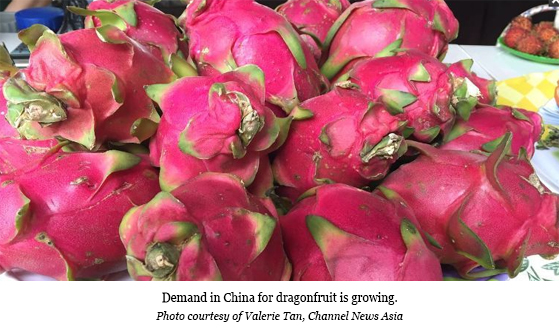by Valerie Tan, Channel News Asia
It may look like overgrown vegetation to some but these plots in Nanning in southern China are gold to Edwin Hooy and his partners.
The 43-year-old Singaporean entrepreneur has invested US$2.3 million in a 200 hectare piece of land to convert it into a dragon fruit farm.

“A large part of China maybe don’t get to eat dragon fruit. Now Beijing, Shanghai they have, (but) what about places like Wuhan, Chengdu, all these are major cities but the people don’t get to buy exotic fruits. Most of the exotic fruits are only available in major cities,” Hooy said.
Demand in China for fruit is growing.
From January to May this year, imports of fresh and dried fruit reached nearly US$3 billion, 37 per cent more than the year before.
Since China signed a Free Trade Agreement with ASEAN five years ago, Nanning has been the gateway for tropical fruits from Southeast Asia to enter China tariff-free, giving Chinese consumers greater access to a huge variety of exotic fruits.
And farmers and retailers are looking to tap into a market that is getting riper by the year.
Fruit is increasingly available in virtual stories, with Alibaba’s online shopping platforms Taobao and Tmall having more than 1.6 million outlets selling fresh produce.
Fruit Day, one of the biggest e-grocers, raked in US$15 million in sales in the first five months of the year, equivalent to a whole year of revenue in 2013. More local farmers are getting in on the act.
“80 percent of dragonfruit is imported from Vietnam. But we see a very strong trend of farmers in Guangxi, in Guangdong, growing dragon fruits. The percentage of imports will reduce over time,” Hooy said.
In for the long haul, his investment is only expected to bear fruit after at least two years. When it does, he expects returns of 30 to 50 per cent in the next two decades.
Source: Channel News Asia
